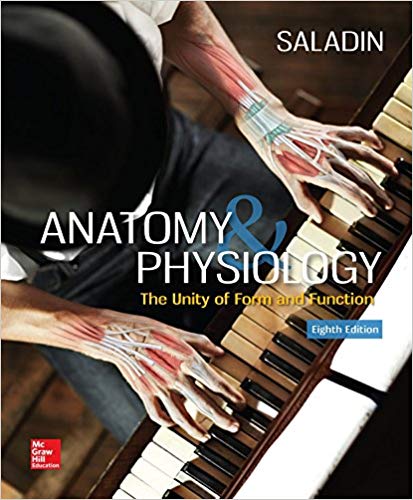Test Bank for Anatomy & Physiology The Unity of Form and Function 8th Edition by Saladin, Kenneth S
Original price was: $55.00.$22.00Current price is: $22.00.
Test Bank for Anatomy & Physiology The Unity of Form and Function 8th Edition by Saladin, Kenneth S is a digital supplement designed to help you improve your understanding of the material covered in the textbook. Test banks typically include multiple choice, short answer, and essay questions. The Test Bank for Anatomy & Physiology The Unity of Form and Function 8th Edition by Saladin, Kenneth S can be used to create practice quizzes and tests, as well as to improve your understanding of the material.
In addition, the Test Bank for Anatomy & Physiology The Unity of Form and Function 8th Edition by Saladin, Kenneth S can be used to prepare for exams. Test banks are an essential tool for any student who wants to succeed in their coursework.
Digital item No Waiting Time Instant Download
ISBN-13: 978-1259277726 ISBN-10: 1259277720
Description
Test Bank for Anatomy & Physiology The Unity of Form and Function 8th Edition by Saladin, Kenneth S
Chapter 02 The Chemistry of Life Answer Key
True / False Questions
|
1. |
Minerals are organic elements extracted from the soil by plants. FALSE |
|
Accessibility: Keyboard Navigation |
|
2. |
Molecules composed of two or more atoms are called compounds. FALSE |
|
Accessibility: Keyboard Navigation |
|
3. |
Hydrogen, deuterium, and tritium are three isotopes of hydrogen. TRUE |
|
Accessibility: Keyboard Navigation |
|
4. |
Potassium, sodium, and chlorine are trace elements. FALSE |
|
Accessibility: Keyboard Navigation |
|
5. |
Ionic bonds break apart in water more easily than covalent bonds do. TRUE |
|
Accessibility: Keyboard Navigation |
|
6. |
A solution is a mixture of two or more substances that are physically blended but not chemically combined. TRUE |
|
Accessibility: Keyboard Navigation |
|
7. |
The pH of blood plasma is approximately 7.4, which is slightly acidic. FALSE |
|
Accessibility: Keyboard Navigation |
|
8. |
The high heat capacity of water makes it a very ineffective coolant. FALSE |
|
Accessibility: Keyboard Navigation |
|
9. |
In an exchange reaction, covalent bonds are broken and new covalent bonds are formed. TRUE |
|
Accessibility: Keyboard Navigation |
|
10. |
Chemical reactions in which larger molecules are broken down into smaller ones are called catabolic reactions. TRUE |
|
Accessibility: Keyboard Navigation |
|
11. |
The opposite of a dehydration synthesis reaction is a hydrolysis reaction. TRUE |
|
Accessibility: Keyboard Navigation |
|
12. |
Unsaturated fatty acids have as much hydrogen as they can carry. FALSE |
|
Accessibility: Keyboard Navigation |
|
13. |
A dipeptide is a molecule with two peptide bonds. FALSE |
|
Accessibility: Keyboard Navigation |
|
14. |
All amino acids have both a carboxyl group and an amino group attached to a central carbon. TRUE |
|
Accessibility: Keyboard Navigation |
|
15. |
ATP is the body’s most important form of long-term energy storage. FALSE |
|
Accessibility: Keyboard Navigation |
Multiple Choice Questions
|
16. |
The most abundant element in the human body, by weight, is __________. A. nitrogen B. hydrogen C. carbon D. oxygen E. calcium |
|
Accessibility: Keyboard Navigation |
|
17. |
Sodium has an atomic number of 11 and an atomic mass of 23. Sodium has __________. A. 12 neutrons and 11 protons B. 12 protons and 11 neutrons C. 12 electrons and 11 neutrons D. 12 protons and 11 electrons E. 12 electrons and 11 protons |
|
Accessibility: Keyboard Navigation |
|
18. |
The chemical properties of an atom are determined by its __________. A. protons B. electrons C. neutrons D. protons and neutrons E. particles |
|
Accessibility: Keyboard Navigation |
|
19. |
Na (atomic no. 11) reacts with Cl (atomic no. 17) to become stable. In the reaction, Na will ____________, while Cl will ____________. A. accept one electron; give up one electron B. give up one proton; accept one proton C. share one electron with chlorine; share one electron with sodium D. become an anion; become a cation E. give up one electron; accept one electron |
|
Accessibility: Keyboard Navigation |
|
20. |
Oxygen has an atomic number of 8 and an atomic mass of 16. How many valence electrons does it have? A. 2 B. 4 C. 6 D. 8 E. 16 |





Be the first to review “Test Bank for Anatomy & Physiology The Unity of Form and Function 8th Edition by Saladin, Kenneth S”